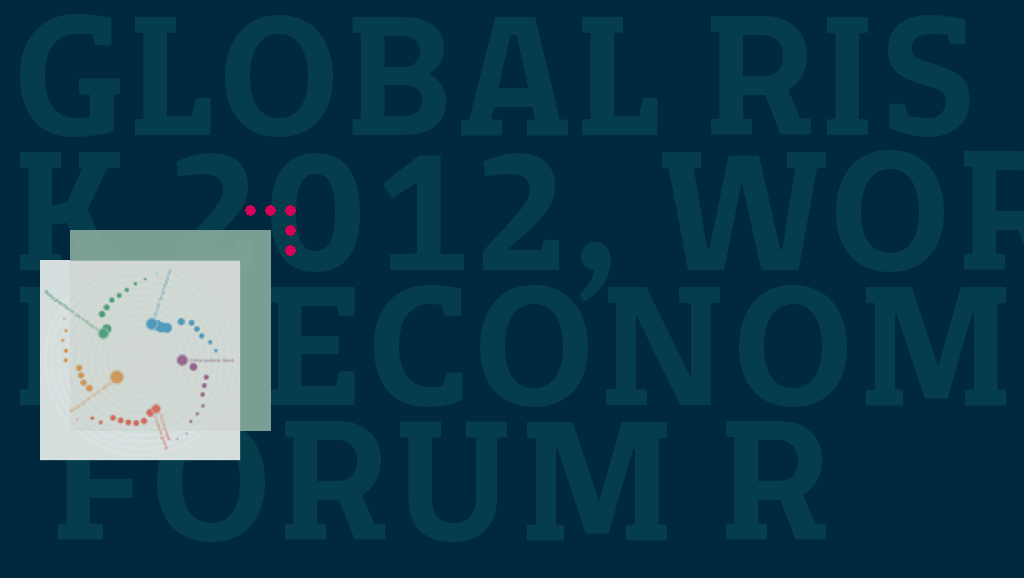Recently the World Economic Forum released its Global Risk 2012 report, the seventh in an annual series of such reports and an initiative of their Risk Response Network. In this article I would like to outline their findings and conclusions.
The report opens with a series of graphs that represent how global risk is perceived by respondents to the Global Risks Survey. The responses are grouped into categories, and this grouping forms the structure of the entire report. The groups are Economic Risks, Environmental Risks, Geopolitical Risks, Societal Risks and Technological Risks. A larger graph follows that places all of the risks together and measures them in terms of likelihood and impact. A large global risk map follows before the report is prefaced, summarized and the methodology explained in the opening section.
Section 2 is divided into 3 major parts, Seeds of Dysopia, How Safe are Safeguards? And The Dark Side of Connectivity. I would like to take a brief look at each of these parts.
The ‘Seeds of Dystopia’ case study looks into how current fiscal and demographic trends could reverse gains brought about by globalization and lead to the creation of critical fragile states. It touches upon the frustration many of the younger generation feel with the political and economic establishment and highlights how political movements can mobilize the public through greater connectivity. It also raises the issue of political and social freedom, arguing that economic growth in many cases leads to a loss of freedom not an improvement.
Income inequality is addressed as is changing demographics, and a conclusion is drawn that when the necessary leadership is lacking or populations are not properly equipped a potential slide into dystopia is made more likely.
Case 2, ‘How safe are our Safeguards?’ finds that the risk of unintended negative consequences of regulations is tightly connected with many other global risks. The example of the grounding of flights due to the eruption of the Eyjafjallajokul volcano in Iceland in 2010 is used to demonstrate how regulations that are too rigid may cause harm, before going on to argue that regulations must be flexible so that they can react as more knowledge is learned in ever developing situations.
Case 3 ‘The Dark Side of Connectivity’ takes a look at risk associated with hyper connected on-line systems. Obvious problems of cyber terrorism are raised but also issues related to how such an interconnectedness of this type makes the issue of risk in general ever more difficult to manage.
Section 3 is an in depth report into the Great East Japan earthquake and its consequences not only for the population of the region but its knock on effect throughout the industrialized world. This section makes for very interesting reading as it shows both the development of forward planning for risk management and its failings in a state that is only too familiar with natural disasters.
Issues of communication and access to reliable data are raised, as are those of working practices and the effects of local culture upon decision-making in a crisis. The domino effects of the crisis are also represented on a graph, before the argument is made that resiliency in complex systems may come from redundancy and a discussion is opened about the value of adaptive leadership.
Section 4 is entitled ‘The Risk Categories’ and is an in depth description and analysis of all of the risk factors measured, their groupings and their relatioships between each other. Their importance relative to others is displayed through gravitational pull in a series of easy to understand graphs and this section really gives an idea of the complexity of risk in a modern world. Unknowns or X Factors are discussed before the issue of responsibility is raised in terms of a hyperconnected world project.
The final section entitled Further Action looks at possible further steps to be taken and “what if” scenarios, before moving on to the conclusion.
The three main points are the following:
Decision-makers need to improve understanding of incentives that will improve collaboration in response to global risk.
Trust or lack of it is perceived to be a crucial factor in how risks manifest themselves. This refers to leaders, public safety systems and communication tools.
Communication and information sharing on risks must be improved.
The theme of risk runs through the mission and work of the Bassetti Foundation, as recent posts show, and I think readers would find this report interesting. It is freely down-loadable on the World Economic Forum website and at 50 pages long plus appendix is a couple of hours well spent.
















